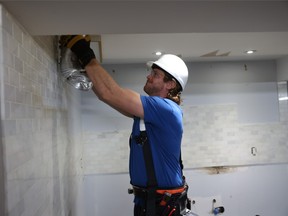
Reviews and recommendations are unbiased and products are independently selected. Postmedia may earn an affiliate commission from purchases made through links on this page.
A couple of weeks ago, I talked about how much I love ERVs for helping maintain healthy indoor air quality, but there are other things homeowners can do to improve the air quality in their homes. Experts suggest we spend about 90 per cent of our time in an indoor space, either at home or at work. A recent study on indoor air quality showed that 62 per cent of homeowners believe a healthy indoor air environment is essential. However, only 12 per cent of homeowners thought their air quality was poor. After being educated on the potential health risks from poor indoor quality, this percentage increased to 39 per cent. So, knowing the risks and understanding how to improve indoor air quality is important.
To deal with poor indoor air quality, you must look into source control, improved ventilation and air cleaners.
Sign up to receive the daily top stories from the National Post, a division of Postmedia Network Inc.
Thanks for signing up!
A welcome email is on its way. If you don't see it, please check your junk folder.
The next issue of NP Posted will soon be in your inbox.
But what does bad indoor air mean? There could be many sources of indoor air pollution in your home, and they’re mostly linked back to toxins or allergens. Creating good air starts with identifying the potential sources that contribute to bad indoor air.
Building materials and furnishings can be a source of toxins, like deteriorated asbestos-containing insulation, newly installed materials such as flooring, upholstery or carpet, or cabinetry or furniture made of certain pressed wood products. If you are renovating your home, building or purchasing a new one, choose materials with low, or even better, no VOCs.
Toxins and allergens can also be found in household cleaning and maintenance products, central heating, cooling systems and humidification devices, as well as, fuel-burning combustion appliances. They’re also found in tobacco products, radon, pesticides, not to mention, all other pollutants.
Poor indoor air can significantly affect our health. Common symptoms can be headaches, tiredness, coughing, sneezing, sinus congestion, shortness of breath, dizziness, nausea, skin irritation, and the list goes on. Plus, if you have allergies or asthma, these often worsen when poor indoor air comes into play.
The first thing I recommend homeowners do is to get their indoor air tested. If you are experiencing any of these symptoms, you should get an air-quality test right away. However, I would also encourage homeowners to get an IAQ test done if they consider buying or selling a home. IAQ tests can be booked through a home inspector. There are also at-home devices on the market, but I don’t trust the accuracy of the DIY air-quality tests as much.
An IAQ test includes testing for radon and mould. Asbestos will require a separate test done by a specialized certified technician. Once you’ve completed a full panel of testing, checkups should be done every five years.
Again, I sound like a broken record, but changing or cleaning your filters regularly (every three or four months), makes a big difference. That applies to your HVAC, ERV or HRV, humidifiers, exhaust fans — any system that moves or extracts air needs regular maintenance.
Make sure you clean your home for dust mites. It may sound creepy, but they are in your bed sheets, curtains, and cushions. Clean these items regularly, especially if you have allergies.
Clean your kitchen and bathroom exhaust fans, and remember to use them regularly, as they are crucial for removing excess moisture from your indoor air. As we know, excess moisture can lead to mould growth. Adequate ventilation ensures that you have good indoor air quality. Improving your ventilation can reduce the number of indoor air pollutants, prevent the buildup of indoor air moisture, and remove stale indoor air.
There have been significant advancements in air purification systems, and I was recently introduced to a compact ceiling-mounted model that keeps indoor air clean and fresh. It purifies contaminated air by inhibiting the growth of bacteria, viruses, allergens and mould, resulting in a healthier home environment.
A simpler solution would be to buy more indoor plants. We should all be aware of the immense power of plants. After all, they are the ones that make the oxygen we breathe. Having plants in your home can help improve the air quality. Plants, like snake plants or spider plants, can absorb pollutants.
The air we breathe will always be essential to our health and well-being, and having good indoor air quality in our homes is especially vital since most of us spend a lot of time in our homes. Having good indoor air will improve the quality of our life and reduce the risk of respiratory infections and several chronic ailments, so it makes sense to take the right and necessary steps to improve indoor air quality.
Residents of the GTA can apply for season 2 of Holmes Family Rescue atmakeitright.ca.


